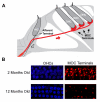Why do hair cells and spiral ganglion neurons in the cochlea die during aging?
- PMID: 22396875
- PMCID: PMC3295057
Why do hair cells and spiral ganglion neurons in the cochlea die during aging?
Abstract
Age-related decline of cochlear function is mainly due to the loss of hair cells and spiral ganglion neurons (SGNs). Recent findings clearly indicate that survival of these two cell types during aging depends on genetic and environmental interactions, and this relationship is seen at the systemic, tissue, cellular, and molecular levels. At cellular and molecular levels, age-related loss of hair cells and SGNs can occur independently, suggesting distinct mechanisms for the death of each during aging. This mechanistic independence is also observed in the loss of medial olivocochlear efferent innervation and outer hair cells during aging, pointing to a universal independent cellular mechanism for age-related neuronal death in the peripheral auditory system. While several molecular signaling pathways are implicated in the age-related loss of hair cells and SGNs, studies with the ability to locally modify gene expression in these cell types are needed to address whether these signaling pathways have direct effects on hair cells and SGNs during aging. Finally, the issue of whether age-related loss of these cells occurs via typical apoptotic pathways requires further examination. As new studies in the field of aging reshape the framework for exploring these underpinnings, understanding of the loss of hair cells and SGNs associated with age and the interventions that can treat and prevent these changes will result in dramatic benefits for an aging population.
Keywords: Aging; Cochlea; Hair cells; Hearing loss; Spiral ganglion neurons.
Figures



References
-
- U.S. National Center for Health Statistics 1994. National Health Interview Survey.
-
- Gates GA, Mills J. Presbycusis. Lancet. 2005;366:1111–20. - PubMed
-
- Dalton DS, Cruickshanks KJ, Klein BE, Klein R, Wiley TL, Nondahl DM. The impact of hearing loss on quality of life in older adults. Gerontologist. 2003;43:661–8. - PubMed
-
- McFadden SL, Ding D, Reaume AG, Flood DG, Salvi RJ. Age-related cochlear hair cell loss is enhanced in mice lacking copper/zinc superoxide dismutase. Neurobiol Aging. 1999;20:1–8. - PubMed
-
- Frisina RD, Walton JP. Aging of the mouse central auditory system. In: Willott JP, editor. Handbook of Mouse Auditory Research: From Behavior to Molecular Biology. New York: CRC Press; 2001. pp. 243–77.
Grants and funding
LinkOut - more resources
Full Text Sources
Research Materials
